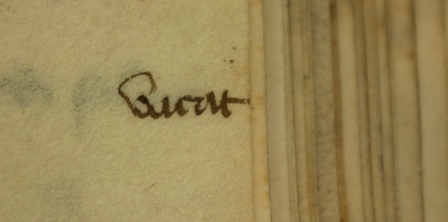Let’s be absolutely truthful about what we know for certain concerning the Fieschi Letter (see the text of the letter here). 1) we know the words contained in the text; and 2) the physical nature of the letter. In other words, we know the content of the text itself, and the fact that this text was copied into a register, which was completed in the 1360s. This register belonged to the Diocese of Maguelone, which has since become the Diocese of Montpellier, hence the the letter is in the archives there. That is all. Everything else is hypothesis, sleuthing and deduction. Everything else must be accompanied by expressions like ‘maybe’, ‘possibly’, ‘perhaps’ and ‘must be’.

In order to better understand the nature of this sleuthing, I want to pay homage to the discoverer of the letter, Alexandre Germain. I want to imagine seeing the letter for the first time, just as he did back in the 1870s. However, we will go through this process of discovery as though it was us looking at it for the first time. This way, some of the possible thought processes involved emerge. Alexandre Germain himself was a famous, distinguished professor of history and head of the department at the University of Montpellier, not a mere mortal like us. He may well have accomplished everything that follows in a matter of minutes, in a largely instinctive manner.
Discovering the Fieschi letter
The fine, beige, almost shiny pages of parchment crackle ever so slightly as we turn them over, one by one. At page 86 we pause. The margins are empty, giving this page a different appearance to all the others. The rest all bear the main text in reddish brown ink, with smaller texts in black ink in the margins, probably markings made by the scribe’s overseer to certify each copy as it was made. They are missing on this particular page. But actually, the margins are not quite empty: in the same ink as the main text, to the extreme right, the word ‘vacat’ (it is vacant/missing) appears, smaller than the main text. What is vacant? What is missing? In other contexts we have seen the word ‘vacat’ used to indicate where portions of text of the original are missing, or where the original itself has since gone missing. But we know that words like this are used in different ways in different times and places, so we can’t draw any firm conclusions. (1)

Now we take a quick look at the first and last lines of the text. The first lines of medieval church documents generally contain a date, written out in words, whilst the last lines list the person who created the document, generally a notary, and the people who witnessed it, generally church officials of some sort. This document cites neither a date, nor a notary, nor witnesses. And it is signed like a letter: ‘Your Manuele Fieschi, notary of the lord Pope, your devoted servant’. How curious! What’s a private letter doing in a register of 13th and 14th century administrative documents relating to the Cathedral of Maguelone?
Let’s see what information we can glean by skimming through the letter for key words, such as names of people, their titles, and the names of places. But even skim reading is no simple thing! 14th century handwriting is a challenge in itself.

We soon realize that the writer never names the person he is writing to. He tells the intended receiver his/her father’s confession, but never names the father either. So who were the intended receiver and his father? What was their relationship to the writer? We now notice that the writer and receiver were not on intimate terms. The intended receiver is addressed in a formal way, using the second-person plural, just like ‘Vous’ in French, but in Latin it is ‘vos’. So now we know that the writer and the intended receiver weren’t on highly intimate terms, such as half-siblings, foster brothers or childhood friends.
We are now faced with an entire document which essentially speaks formally to an unidentified ‘you’, and talks about ‘your father’, and the name of the father is never mentioned either. Let’s look again at the end of the document, there must be a clue somewhere. Yes, this Manuele Fieschi character recommends the letter to the attention of ‘vestre dominacionis’, so this was the title of the intended receiver. ‘Dominacionis’ comes from the same root as domus (house), dominus (which in its most essential meaning could be something like ‘master of the house’), and ‘dominatio’ from which derives our English ‘domination‘, to rule over. But we know that this expression in the Latin of the time could have been appropriate for a great lord, a duke or a prince, a King or even the Emperor. So, the letter is intended for a very important person, but we don’t know their specific rank.
Our eyes alight on a piece of direct speech. A servant is addressing the father, and calls him ‘dominus’. This is one of the few Latin words that English speakers are familiar with today, thanks to hymns and church music, but it doesn’t help enormously. This term could be appropriate address for everyone from a lower ranking but respected individual (a householder without noble rank) right up to the Emperor, the Pope and God. In fact, Manuele Fieschi identifies himself as ‘domini pape notarius’, notary of ‘dominus’ Pope. It’s vague, but there’s no help for it. It makes us think of the way that, today, one might tap a gentleman on the arm to get his attention and say ‘excuse me sir’. We don’t mean that the gentleman has been knighted, this is just a form of address. Indeed, we know that the female equivalent of ‘dominus’, which is ‘domina’, was used irrespectively of rank in what is now Italy to the extent that its derivative ‘donna‘ now generically means woman.
Now let’s look at the place names. Perhaps we can identify which corner of the continent the Letter talks about. And there, we find a great surprise. The letter begins by saying that the father understood that all of England was against him. England! The following place-names are unfamiliar, particularly with the erratic, unpredictable spelling that is typical of medieval documents. For example, where is this castle called ‘Berchele’? Then we find an interesting name: Henricus de Longo Castello. Isn’t ‘Longo Castello’ pretty much the Italian for ‘Long Castle’? Let’s Anglify it a little… Longchester? Longcaster… What’s ‘long’ in Old English? ‘Lang’… Langcaster, Lancaster!’

Next, our gaze falls upon another familiar-looking word – ‘coronam’. This is the accusative case for ‘corona’, or crown. We pause to translate the whole phrase, and are startled to learn that the father of the receiver loses his crown. He is a king! Now our attention is completely riveted on this letter. It’s not everyday you come across the confession of a king, after all.
We continue through the letter, until we reach the section describing how the two assassins presented the murdered gate-keeper’s body and heart to the queen ‘as that of your father, and as the king’s body it was buried in Gloucester’. Now we finally have an element that can tell us who the mysterious ‘father’ is. He was a King buried in Gloucester. We reach across to our tablet and swiftly search for… Oh, this is the 1870s. Um, we search back in our memory to our school days, when we were forced to learn the complete succession of the Kings of England, and we remember that the only king buried in Gloucester was Edward II, after the infamous red-hot poker murder in Berkeley Castle (‘Ah!’ we think ‘so that’s the place the letter calls ‘Berchele’) After a little research, we realise that the letter goes far beyond accepted knowledge about the death of Edward II, claiming that he escaped death in Berkeley Castle and went on to become a pilgrim and hermit far away on the continent – after meeting the Pope in Avignon!
Upon discovering the letter, Germain no doubt believed that he was re-writing a page of history. And it couldn’t have happened to a more deserving person: it took enormous preparation and special qualities to notice and identify the Fieschi Letter. Germain and his colleagues in France and Italy seem to have embraced the story told in the letter fairly easily. After all, the loss to the English of the bones of one of their kings was hardly a matter of concern to them. I wonder if the great Germain would have been put out by the way the English very calmly dismissed the letter as sheer falsehood for the following one hundred and twenty-odd years?
The main source for this blog post is Seymour Phillips biography of Edward II, 2010, chapter 12, Afterlives, pg 583-585. The Auramala Project verified this information, and expanded on it, during a visit to the Archives départementales de l’Hérault, where the Fieschi Letter is to be found, in early August, 2013.
(1) For example, we found ‘vacat’ used to mean missing portions of text and/or a missing original in: Cammarata, Italo, Cronache del marchesato. Documenti per la storia della rocca di Oramala, del Castello di Cella e dell’Abbazia di S. Alberto, Guardamagna, 2006
A fascinating “you were there” sort of analysis of the discovery of this letter. I’ve been following the course of your research into the true fate of Edward II with great interest. It’s one of my favorite historical riddles.
Yes, finding a document like this would be every researcher’s greatest dream. I only hope that soon, orthodox history will be compelled to take it a bit more seriously.
Thank you Undine, I’m glad you liked this approach. What I really want to do is put the people in the driver’s seat as much as possible, and show them the kind of processes historical research entails firsthand. I hope that people will realize that historians are not an elite cast of high priests of the truth, abdthat lay people will feel empowered enough to make their own judgements about what may or may not have happened.
I’m pretty sure history, and other academic disciplines, are slowly going through what the music industry, and then the publishing industry have gone through due to internet: a liberalization process that will force the old dogs in the game – orthodox history – to pull their socks up.
Do I see in your profile that you run a website on Edgar Allan Poe? I will take a look, I am fascinated by the symbolic elements of his writing.
Yes,my Poe blog is largely “at rest” now, but I kept the weird little thing going for about three years. I focused mainly on the biographical aspects of his life–namely, that historians got nearly everything about him wrong. Sound familiar? :)
Absolutely! Kathryn Warner’s Edwardthesecond blogspot sets has been setting the story straight for 8 years, but very few people seem to want to let the truth get in the way of… Um… Let’s face it, very bad stories about Edward II.
By the way, the ‘you were there approach’ was suggested by Elena Corbellini. An old trick of hers from her days as a journalist.